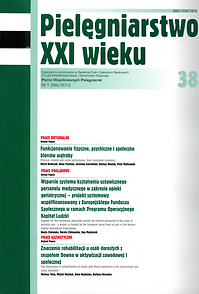Midwives’ knowledge concerning the prophylaxis of pelvic organ prolapse and stress urinary incontinence
Keywords:
prophylaxis, pelvic organ prolapse, stress urinary incontinence, knowledge, midwifeAbstract
MIDWIVES’ KNOWLEDGE CONCERNING THE PROPHYLAXIS OF PELVIC ORGAN PROLAPSE AND STRESS URINARY INCONTINENCE
Introduction. Pelvic organ prolapse and stress urinary incontinence are one the most common problems women experience at different stages of life. They can be prevented by taking proper prophylaxis. These prevention measures should consist in encouraging a healthy lifestyle, exercising regularly in order to strengthen the pelvic diaphragm, obesity prevention and countering constipation. These steps may be taken by women of all ages although the most significant stages in life are the perinatal period, the postnatal period and the perioperative period (surgeries within the abdominal cavity).
Aim. The aim of the paper is to present midwives’ knowledge about the prevention of pelvic organ prolapse and stress urinary incontinence.
Material and methods. The material for the research are based on surveys obtained from 50 midwives who took part in the research conducted in November and December 2009. The research was conducted in the Provincial Specialist Hospital in Rzeszów.
Results. The factors particularly influencing the level of knowledge were: seniority and work experience – longer-serving employees with wider experience much more frequently provided their charges with training. Furthermore, respondents who took part in various forms of in-service training had a broader scope of knowledge in the field than the rest of the questioned.
Conclusions. The knowledge concerning pelvic organ prolapse and stress urinary incontinence among the researched nurses is on an average level and depends on their seniority and work experience. Hence, constant training in the subject of pelvic organ prolapse and stress urinary incontinence is justified and valid. It may improve communication with patients and positively affect their satisfaction with care provided.
References
1. Płachta Z, Adamiak A, Jankiewicz K, i wsp. Ocena jakości życia u pacjentek po pętlowej operacji wysiłkowego nietrzymania moczu z zastosowaniem taśmy polipropylenowej – TVT i IVS. Ginekologia Polska; 2003. s. 986 – 991.
2. Cayan F, Dilek S, Akbay E. et al. Sexual function after surgery for stress urinary incontinence: Vaginal sling versus Burch colposuspension, Arch Gynecol. Obstet. 2008; 277:31-36.
3. Domingo S, Alama P, Ruiz N. et al. Transobturator tape procedure outcome: a clinical and quality of life analysis of a 1-year follow-up, Int Urogynecol J Pelvic Floor Dysfunct 2007; 18: 895-900.
4. Jha S, Moran P, Greenham H. et al. Sexual function followimg surgery for urodynamic stress incontinence, Int. Urogynecol J Pelvic Floor Dysfunct 2007; 18: 845-850.
5. Darewicz B, Skrodzka M, Kudelski J. Problemy urologiczne kobiet okresu pomenopauzalnego. Przegląd Menopauzalny. 2008; 4: 175-183.
6. Ge J, Yang P, Zhang Y, et al. Prevalence and Risk Factors of Urinary Incontinence in Chinese Women: A Population-Based Study, Asia Pac. J Public Health. 2011; Dec 20.
7. Qiu J, Lv L, Lin X. et al. Body mass index, recreational physical activity and female urinary incontinence in Gansu, China. European Journal of Obstertics & Gynecology and Reproductive Biology. 2011; 159 (1): 224-9.
8. Skręt - Magierło J. Zaburzenia statyki żeńskich narządów płciowych, [w:] Bręborowicz G. (red.) Położnictwo i Ginekologia. Warszawa: PZWL, Tom II; 2008, s.601 – 621.
9. Norton P, Brubaker L. Urinary incontinence in woman, Seminar, 2006; 57 – 67.
10. Gamble TL, Du H, Sand PK et al. Urge incontinence: estimating environmental and obstetrical risk factors using an identical twin study. Int Urogynecol J. 2010 Aug; 21 (8): 939-46.
11. Menezes M, Pereira M, Hextall A. Predictors of femaleurinary incontinence at midlife and beyond Maturitas. 2010; 65 (2): 167-71.
12. Ham E, Choi H, Seo JT et al. Risk factors for female urinary incontinence among middle-aged Korean women. J Womens Health. 2009; 18 (11): 1801-6.
13. El-Azab AS, Mohamed EM, Sabra HI. The prevalence and risk factors of urinary incontinence and its influence on the quality of life among Egyptian women, NeurourolUrodyn. 2007; 26 (6): 783-8.
14. Henderson JS, Kashka MS. Effect of knowlegde attitude, and belief on nurse’s practice regards urinary incontinence in adults. Urologi Nursing 2000; 20 (5): 291-305.
15. Saxer S , A. de Bie R, Dassen T et al. Nurses’ knowledge and practice about urinary incontinence in nursing home care. Nurse Education Today 2008; 28: 926-934.
16. Rechberger T, Postawski K. Problemy uroginekologiczne u kobiet po wystąpieniu menopauzy. Nowa Medycyna – Zdrowie kobiety w kolejnych okresach życia 2004 (1).
17. Miękoś E, Sosnowski M, Zydek C. Czynniki ryzyka występowania i zapobieganie nietrzymaniu moczu u kobiet. Przegląd Menopauzalny; 2004 (5): 43–49.
18. Skrzypulec V, Piela B, Drosdol A. Życie seksualne kobiet po operacjach uroginekologicznych. Seksuologia Polska. 2006; 4. (1): 16-20.
19. Żołnierczuk - Kieliszek D, Kulik TB, Wiktor H. i wsp. Status menopauzalny i przeszłość ginekologiczna a jakość życia kobiet w wieku 45-65 lat. Zdr. Publ. 2010; 120 (3): 234-238.
20. Butterfield YC et al. Peripartum urinary incontinence: A study of midwives’ knowledge and practices. Women and Birth 2007; 20: 65—69.
21. Adaji SE, Shittu OS, Bature SB et al. Suffering in silence: pregnant women’s experience of urinary incontinence in Zaria, Nigeria. European Journal of Obstetrics & Gynecology and Reproductive Biology 150. 2010; 19–23.
22. Whitford HM, Alder B, Jones M. A cross-sectional study of knowledge and practice of pelvicfloor exercises during pregnancy and associated symptoms of stress urinary incontinence in North-East Scotland. Midwifery 2007; 23: 204–217.
23. Kubik K, Blackwell L, Heit M. Does socioeconomic status explain racial differences in urinary incontinence knowledge? American Journal of Obstetrics and Gynecology, 2004; 191: 188-93.
24. Burti J.S, et al. Prevalence and clinical characteristics of urinary incontinence in elderly individuals of a low income. Arch. Gerontol. Geriatr. 2011; 54.(2) s. 42-46.
Downloads
Published
Issue
Section
License
Copyright (c) 2012 Joanna Trawińska, Edyta Barnaś, Renata Raś, Elżbieta Kraśnianin, Bożena Bytnar (Autor)

This work is licensed under a Creative Commons Attribution 4.0 International License.




